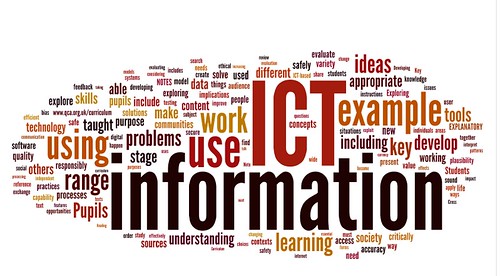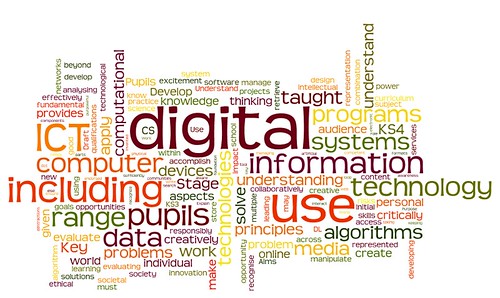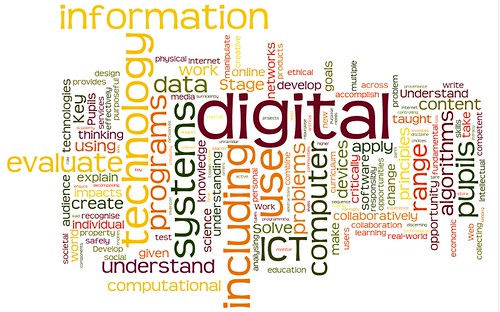C is for … Curriculum
There has been much discussion about the curriculum in general in England recently, and the ICT curriculum in particular. I wrote about the latter a few months ago, in an article entitled 5 Characteristics of an Ideal Programme of Study for ICT. Now, three months and two draft versions of a new ICT Programme of Study later, I should like to put forward a few comments, both about the area of “ICT curriculum” in general, and about recent developments in the UK in particular.
What is the purpose of an ICT curriculum?
In my opinion, the curriculum in any subject should be a bare bones outline of what should be taught. In this regard, the instruction to come up with a draft ICT curriculum which takes up no more than 2 sides of A4 is absolutely right. However, many people contributed to online discussions making the case for particular bits and pieces to be added. So much so, in fact, that at one stage I was tempted to write to Michael Gove, the English Education Secretary, to ask if there was any minimum font size that could be applied to the two-sided document.
I think that all the detail should be left for two other sorts of document: a syllabus, and a scheme of work. Thus a school, or an examination awarding body, would wish to construct a syllabus that fleshes out what the curriculum is getting at, while the nitty-gritty detail of what is to be done in which order and with what resources is to be reserved for the scheme of work.
Not only does this approach ensure that the right amount of detail is given in each type document as appropriate, it also ensures that schools have more say in what they teach, and also that there is less opportunity for micromanagement of schools by politicians (or anyone else). In my opinion, schools are better placed than anyone else to decide what is the most appropriate, exciting, useful bill of fare for their pupils.
It also avoids some own-goals, of which I think one is e-safety, even though it is one of the things being sought after by the ICT community, and which has been included in the drafts to some extent. I think this is a mistake, for two reasons.
First, I think e-safety should be a concern of the whole school, and therefore everyone in it, rather than a particular subject area. It should be considered as part of child safety in general, but with specific features which need to be addressed, and for which people (may) require training.
Second, I think you get into a silly semantic situation, similar to one I experienced in a supermarket recently. I noticed that there was a range of soups described as “healthy (see photo below). Does that mean that, as a general rule, all the other soups are unhealthy, or that I can ask to see the unhealthy range?
In the same way, I think sentences like “use the internet safely” are a statement of the obvious or, worse, that the standard practice in the school is to not be aware of safety issues.
 Excuse me, where are the UNhealthy options please?
Excuse me, where are the UNhealthy options please?
Who should decide what’s taught?
When I put it to a fellow consultant recently that I think teachers and schools should decide what’s taught in the ICT curriculum, his response was that teachers are there to do the client’s bidding – the “client”, in this case, being, I suppose, society at large. Just as, for example, you might call a plumber and tell him you need a new sink, but not how to go about installing it.
Well, maybe, but…
First, if you trusted your plumber, you wouldn’t say “I need a new sink”. You would say “I think I may need a new sink; what I am trying to achieve is X”. Your plumber would then either tell you that you do indeed need a new sink, or that you can carry on using your current one if a few adjustments are made.
Second, however, who exactly is acting as the representative of this “client”. The group responsible for the initial draft of the new ICT Programme of Study did not include many teachers, or many women (see the Naace document about the consultation). As far as I can tell, it included no parents in their capacity as parents, or school governors (ditto), and certainly no students. In my opinion, whatever the final ICT Programme of Study looks like, it would have had greater legitimacy/authority had the composition of the group been more representative of both consumers and producers of the ICT curriculum. At least there has been the opportunity to contribute our thoughts and opinions to the initial draft, and to discuss the initial and final drafts (see the Naace document referred to above for the initial draft). I would urge everyone to contribute to the public consultation about it in 2013.
What does it all mean?
There always seems to have been a problem of defining exactly what is meant by ICT, digital literacy and any number of other terms used for technology in the curriculum. I think, as a general rule, the simpler the better. Peter Twining, on the Edfutures website, says:
You will know that I think folk get very confused about terms such as ICT – at present that seems to be used to mean four different things:
ICT – the digital technology itself ICT – the subject called ICT ICT – the use of digital technology in other subjects because it has changed the nature of that subject (so the technology has become an embedded element of the other subject) ICT – the use of digital technology to support teaching (pedagogy) Wouldn't it be helpful to have different terms for each of those things?
I'd suggest:
Digital technology to refer to the technology itself ICT to refer to the subject called ICT Embedded technology to refer to the use of digital technology where it has changed the nature of other subjects as is thus now an integral part of them TEL (Technology Enhanced Learning) where digital technology extends our repertoire of teaching strategies/methods (Pedagogy)
I think he is on the right lines, especially when you consider the slightly confusing terminology that has found its way into the draft ICT Programme of Study:
-
- Digital Literacy is the ability to access, use, and express oneself using digital technology, including a critical understanding of technology’s impact on the individual and society.
- Information Technology covers the purposeful creation and application of digital systems to develop products and solutions.
- Computer Science is the discipline that explains how digital systems work, how they are designed and programmed, and the fundamental principles of information and computation.
At least the accompanying guidance notes state that:
the three [terms] are closely related, overlap, and should not be thought of as “silos” into which lessons can be categorised. For example, use of a spreadsheet might be considered information technology, but use of formulae crosses over into an exercise in programming.
But that’s another thing: why do we need a guidance document that is five times longer than the document on which it is providing guidance? Something is wrong, and it isn’t just the introduction of the term “decomposing” to mean breaking a problem down into sub-problems; I always thought that decomposing is what dead organisms do.
What’s changed?
Should an ICT curriculum include computer programming and the like? In England, that is what is going to happen. Or at least, computer programming is going to be made much more explicit than before. Interestingly, however, that fact doesn’t manifest itself when you carry out a word analysis using Wordle. I carried out a Wordle analysis of the original ICT Programme of Study, the initial draft of the new ICT Programme of Study, and the final draft of the new ICT Programme of Study. Here is what they look like:
 The original ICT Programme of Study
The original ICT Programme of Study
 Initial draft of the new ICT Programme of Study
Initial draft of the new ICT Programme of Study
 Final draft of the new ICT Programme of Study
Final draft of the new ICT Programme of Study
Think how much clearer the Wordle would be if the ICT Programme of Study consisted of a few definitions, and nothing else! In an ideal world, the Wordle should give you an instant impression of what the document is all about. Do any of these do that?
Perhaps therein lies the answer. Maybe we would end up with a much clearer ICT curriculum, if we started at the end, ie thought about what we would like a Wordle of it to convey.
Happy New Year!